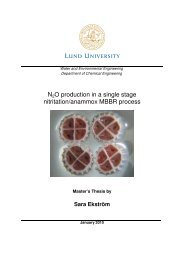Alexander Szabo and Oscar Engle - Svenskt Vatten
Alexander Szabo and Oscar Engle - Svenskt Vatten
Alexander Szabo and Oscar Engle - Svenskt Vatten
You also want an ePaper? Increase the reach of your titles
YUMPU automatically turns print PDFs into web optimized ePapers that Google loves.
8. Water flow <strong>and</strong> quality<br />
Sampling procedure for effluent water<br />
Effluent samples were collected every two hours from the pond outlet at the 5-6 November, 18-19<br />
November <strong>and</strong> 9-10 January. From the samples made COD, BOD <strong>and</strong> TSS were analyzed. Since<br />
the ponds have large volumes <strong>and</strong> the retention time is several days, the effluent quality does not<br />
change drastically during a time span of a few hours. Therefore, for 5-6 November <strong>and</strong> 9-10<br />
January, composite samples were created from three effluent samples under approximately a 6<br />
hour period. This was done in order to reduce work <strong>and</strong> costs in the laboratory. The analysis<br />
procedures are described in chapter 7.<br />
De-sludging conditions<br />
The treatment efficiency is dependent on the sludge, since the sludge contains bacteria that<br />
degrade pollutants in the waste water. If the sludge has been removed recently, the system may<br />
operate ineffectively due to the lack of bacteria. If however, the sludge has accumulated for a<br />
long period, the volume of the sludge will reduce the HRT in the pond system, hence making the<br />
treatment less effective. One can assume that the best treatment occurs somewhere in the middle<br />
between the de-sludging operations.<br />
The WSP (north treatment line) was de-sludged after the first measurements were done on the 5-6<br />
November 2009. During de-sludging one treatment line at a time is closed down. The waste water<br />
is pumped out <strong>and</strong> the accumulated sludge from the bottom of the ponds is removed. The desludging<br />
operation takes a few weeks to be completed <strong>and</strong> is done with 10 year intervals. On the<br />
9-10 January 2010, the WSP had been in operation, after de-sludging, for about 2 weeks when the<br />
samples were collected. The average effluent COD was 64 mg/l before <strong>and</strong> 58 mg/l after desludging<br />
(see Figure 8.1 <strong>and</strong> 8.2). The average BOD 5 for 5-6 November was 39 mg/l BOD 5 on<br />
average (Figure 8.1).<br />
Since the samples were collected just before <strong>and</strong> after de-sludging, the results presented above<br />
may be slightly higher than during most of the operation time. Zahari & Zain (1999) showed in<br />
their report an average effluent of 40 mg/l COD (see Appendix A) which is approximately 30%<br />
better than the results in this report. This could be due to the sludge conditions discussed above.<br />
BOD 5 <strong>and</strong> COD in effluent<br />
The quality of the effluent water is relatively stable (see Figure 8.1 <strong>and</strong> 8.2). Variations may<br />
depend on sunlight that changes the concentrations of algae in the surface layer. Another factor to<br />
consider is the effluent pump that is working discontinuously where the treated waste water is<br />
released to the small stream when the waterlevel in the ponds has reached a certain level (more<br />
information about the pumping effect is discussed on page 36).<br />
<br />
37















